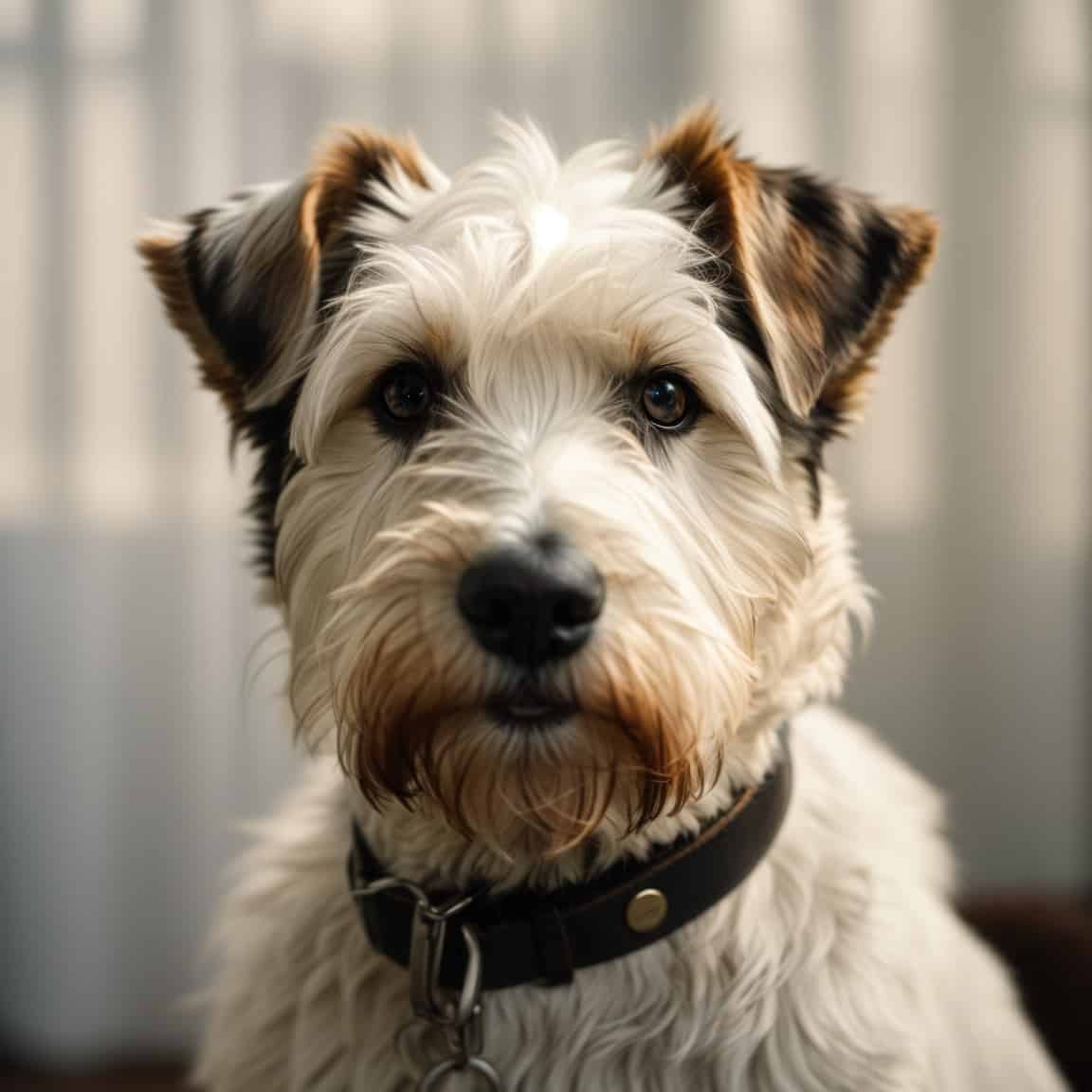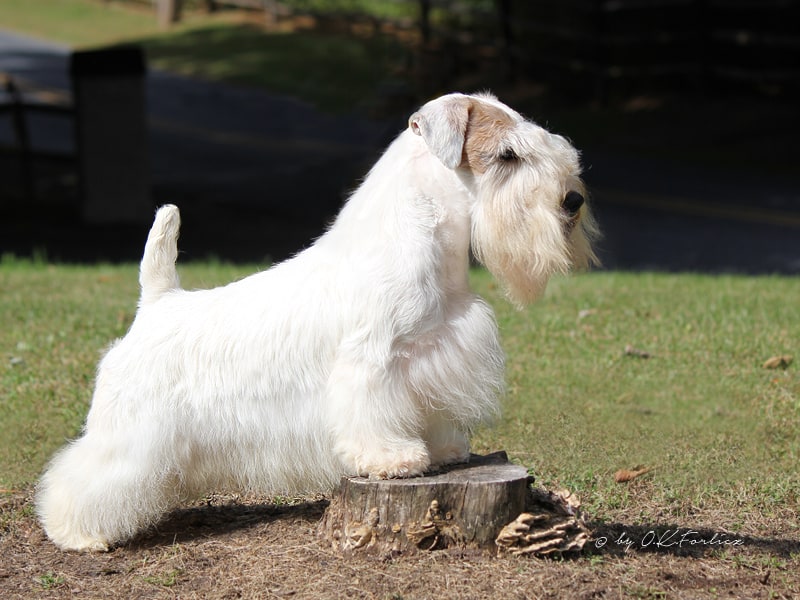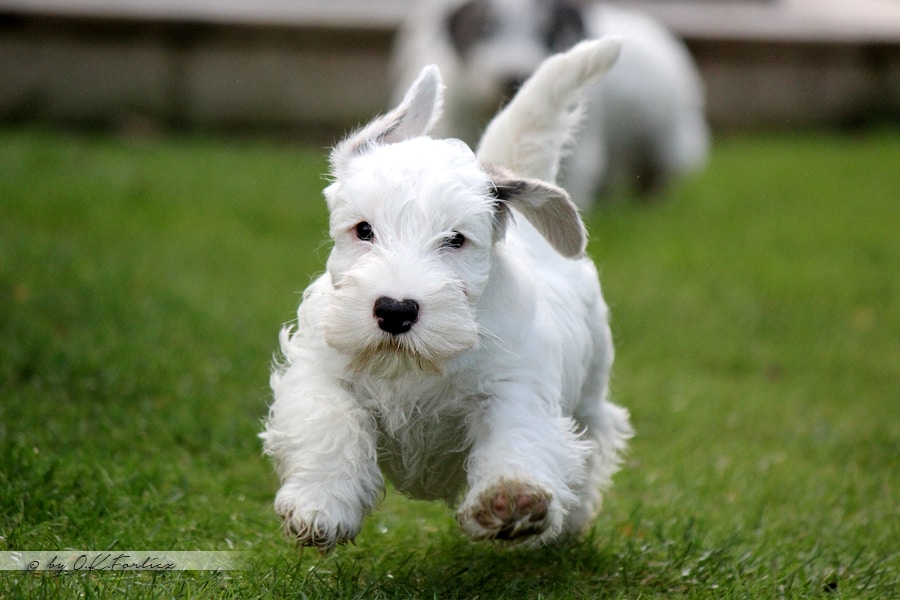Sealyham Terriers are known for their distinct appearance and confident demeanor. Learn about their history, the care they deserve, and the spirited nature that makes Sealyhams delightful companions.

| Category (Explanation) | Breed Information |
|---|---|
| Year of Breed Conception | 1800s |
| Country of Origin | Wales |
| Weight (lbs & kg) (Male) | 23-24 lbs (10.5-11 kg) |
| Weight (lbs & kg) (Female) | 18-20 lbs (8-9 kg) |
| Coat Type | Dense, wiry, weather-resistant double coat |
| Color Variations | White |
| Shedding Level (Low, Moderate, High) | Low to Moderate |
| Height (cm & in) | 10.5-11.5 inches (27-29 cm) |
| Breed Size | Small |
| Trainability (Low, Moderate, High) | Moderate |
| Mental Needs (Low, Moderate, High) | Moderate |
| Intelligence Level (Low, Moderate, High) | High |
| Energy Level (Low, Moderate, High) | Moderate |
| Agility (Low, Moderate, High) | Moderate |
| Loyalty (Low, Moderate, High) | High |
| Playfulness (Low, Moderate, High) | Moderate |
| Exercise Needs | Regular exercise and mental stimulation |
| Guarding Proficiency (Low, Moderate, High) | Moderate |
| Sociability with Children (Low, Moderate, High) | High |
| Barking Level (Low, Moderate, High) | Moderate |
| Digging Tendency (Low, Moderate, High) | Moderate |
| Destructive Behavior (Low, Moderate, High) | Low |
| Drooling Level (Low, Moderate, High) | Low |
| Obedience Level (Low, Moderate, High) | Moderate |
| Apartment Friendly (Yes/No) | Yes, with sufficient exercise and mental stimulation |
| Inherent Prey Drive | Moderate |
| Physical Risk to Others (Low, Moderate, High) | Low |
| Travel Fatality Risk (Low, Moderate, High) | Low |
| Allergen Potential | Low |
| Health Concerns (List of Common Health Concerns) | Lens Luxation, Hip Dysplasia, Allergies |
| Average Life Expectancy (Life Expectancy in Years) | 12-14 years |
Woof Mastery is reader supported and our articles may contain affiliate links.
Instead of running third party ads that we have no control of we only use links from high-quality companies we are directly partnered with. Making use of these links come at no cost to you our reader, and in many cases have the extra benefit of discounted rates or sign up bonuses.
If you’re interested you can read more about our affiliate policy here.
We appreciate your support and always insure that the products and services we recommend are high-quality, helpful and relevant to the subject at hand!
The Sealyham Terrier, named after Sealyham, the estate of its creator, Captain John Edwardes, in Wales, has a distinguished history dating back to the mid-19th century. Captain Edwardes aimed to develop a terrier suitable for hunting small game on his estate.
The breed’s development involved crossing various terriers, including the Dandie Dinmont Terrier and the West Highland White Terrier. The Sealyham Terrier gained popularity among the British aristocracy and later in the United States. It became known for its distinctive appearance, including a white coat and lively personality. Despite facing challenges, the Sealyham Terrier has maintained its charm and remains a cherished companion and show dog.

Sealyham Terriers are known for their distinct appearance and confident demeanor. What makes them special is their distinct appearance, confident disposition, and spirited nature. Learn about their history, the care they deserve, and appreciate the spirited nature that makes Sealyhams delightful companions. Sealyham Terriers are special for their regal appearance and confident personality, adding elegance and charm to their owners’ lives.
Sealyham Terriers were originally bred for a specific traditional role: hunting small game, including otters, foxes, and badgers in Wales. Their distinct appearance and confident demeanor served them well in these hunting pursuits. Their adaptability and spirited nature made them valuable assets to hunters, and their affectionate disposition ensured their place as loyal companions in the home. This breed embodies a rich history of hunting and companionship.
Sealyham Terriers are known for their distinct appearance and confident demeanor. They are characterized by their confident and distinct appearance. These terriers can be loving and make delightful companions. They are known for their confident appearance and require training and socialization to ensure they are well-behaved and spirited family pets.
Sealyham Terriers are known for their distinct appearance and confident demeanor. They are typically affectionate and spirited dogs. Their loving nature makes them great companions. However, they may exhibit stubbornness at times. Early training and socialization are essential to ensure they develop into well-adjusted pets. Their alertness and adaptability make them suitable for various living situations.
Sealyham Terriers are small dogs with a distinctive appearance, including a dense, weather-resistant coat that’s predominantly white with tan, lemon, or badger markings. They have a well-proportioned body with a flat skull, dark, expressive eyes, and V-shaped ears that fold forward. Sealyham Terriers have a straight tail and sturdy legs. They have a confident and spirited gait, reflecting their confident and lively demeanor.
Sealyham Terriers typically have a white coat that may sometimes have markings in lemon, brown, or black. The white coat is often the dominant color, and the other shades may appear as markings or patches on their body.
Sealyham Terriers have a distinctive and dense double coat that is typically all white. Their coat adds to their confident and spirited appearance, making them stand out with their all-white elegance.
Sealyham Terriers have a low shedding level. These small terriers have a dense, wiry coat that requires regular grooming to maintain its quality. While they shed minimally, brushing their coat a few times a week helps remove loose hair and prevents matting. The grooming routine for Sealyham Terriers includes plucking or stripping to remove dead hair and maintain the characteristic texture of their coat. Proper grooming, along with a balanced diet and regular veterinary check-ups, can contribute to a healthy coat and minimize shedding.
Sealyham Terriers have a dense, wiry coat that requires regular grooming to maintain its texture and appearance.
Brushing: Brush their coat a few times a week to remove loose hair and prevent matting. Use a slicker brush or a comb suitable for their coat type.
Stripping: Hand-stripping or plucking may be necessary to maintain the breed’s distinctive coat texture. Consult a professional groomer for guidance on this technique.
Bathing: Bathe as needed, typically every few months, to keep their coat clean. Use a dog shampoo suitable for wiry coats and rinse thoroughly.
Ears: Check and clean their ears regularly to prevent wax buildup or infections. Use a damp cotton ball or a veterinarian-recommended ear cleaning solution.
Nails: Keep their nails trimmed to a comfortable length for good foot health.
Teeth: Brush their teeth regularly to prevent dental issues and bad breath.
Sealyham Terriers have a moderate activity level. These small terriers enjoy playtime and daily walks to fulfill their exercise needs. While they are not excessively hyperactive, providing mental stimulation through interactive toys and training sessions is beneficial. Sealyham Terriers thrive on companionship and may enjoy interactive games with their owners.
Sealyham Terriers are known for their intelligence, marked by problem-solving abilities, adaptability, and a desire to please their owners. They are generally trainable and responsive to positive reinforcement training methods. Sealyham Terriers can learn various commands and tasks. Their adaptability allows them to thrive in different living environments. Historically, they were skilled in roles such as hunting and vermin control, showcasing social intelligence by forming strong bonds with their families. While they may not top the charts in terms of obedience, their intelligence makes them excellent companions and working dogs. Training, socialization, and mental stimulation contribute to their well-rounded and obedient nature.
Sealyham Terriers benefit from mental stimulation to prevent boredom. Engage them in activities like puzzle toys, interactive games, and training sessions to keep their minds active.
Social Interaction: They enjoy spending time with their family and need regular companionship. Loneliness can lead to anxiety, so provide attention and interaction.
Exercise: While not overly active, they still require regular exercise for their mental and physical well-being. Daily walks and play sessions are suitable.
Enter The Woof Mastery

Prospective owners of Sealyham Terriers should be ready for a charming and spirited companion. Regular exercise and mental stimulation contribute to their well-being. Grooming their distinctive coat is important for its upkeep. Sealyham Terriers are known for their independent nature, so early training and socialization are crucial. Potential health concerns should be monitored with regular veterinary check-ups. A loving and engaging environment is key to ensuring the happiness and well-rounded behavior of these affectionate and confident dogs.
Sealyham Terriers, known for their friendly and confident nature, generally pose a low risk to others. Proper socialization and training contribute to positive interactions. Responsible ownership, understanding individual temperament, and adherence to local regulations play crucial roles in ensuring a well-behaved Sealyham Terrier.
Sealyham Terriers can be good with children when properly socialized. Supervision is important during play, and positive reinforcement training helps ensure positive interactions. Teaching children how to approach and handle the dog contributes to a positive relationship.
Sealyham Terriers may have mixed responses to water. Some individuals may enjoy swimming, while others may not be as comfortable. If you plan to introduce them to water, do so gradually and observe their comfort level. Always prioritize safety and use a canine life vest if needed, especially in situations where they may be at risk of fatigue.
Remember that Sealyham Terrier puppies, like all puppies, are eager to please and learn. Positive and consistent training practices will help them become well-behaved, obedient, and happy adult dogs. Building a strong and trusting bond with your puppy through training is a rewarding experience for both you and your canine companion.
Sealyham Terriers may have moderate barking tendencies. They are alert and may bark to alert their owners or express themselves. Early training and socialization play a crucial role in managing their barking behavior and teaching them appropriate times to vocalize.
Sealyham Terriers thrive in homes with active families who can provide regular exercise and mental stimulation. They adapt well to various living situations, including apartments, as long as they receive ample attention and playtime. Secure fencing is essential for their safety when outdoors.
When traveling with Sealyham Terriers, consider their comfort and safety:
Addressing these considerations helps ensure safe and comfortable travel for Sealyham Terriers.
Sealyham Terriers may be prone to certain health concerns. While individual dogs may not experience all these issues, it’s crucial for Sealyham Terrier owners to be aware of potential health problems and collaborate with veterinarians for their pets’ well-being. Common health concerns in Sealyham Terriers include:
Regular veterinary check-ups, a balanced diet, proper exercise, and responsible breeding practices can contribute to the overall health and well-being of Sealyham Terriers.
Proper nutrition is essential for the health and well-being of Sealyham Terriers. Here are some nutritional habits and best practices to consider for this breed:
Breed-Specific Laws (BSL): Sealyham Terriers may be subject to breed-specific laws (BSL) in certain areas. These laws are often enacted at the local or municipal level and can vary widely from one jurisdiction to another.
Types of Restrictions: The specific restrictions imposed on Sealyham Terriers under BSL can include mandatory spaying/neutering, special licensing, liability insurance requirements, muzzling in public, and, in some cases, bans on ownership. The severity of these restrictions depends on local regulations.
Rationale for BSL: BSL is typically implemented based on concerns about public safety and perceived risks associated with specific breeds, often due to incidents involving dog attacks. While Sealyham Terriers are not inherently aggressive, they can be affected by BSL due to their physical resemblance to breeds that are sometimes included in these laws.
Controversy: It’s important to note that BSL is a controversial topic. Critics argue that it unfairly targets breeds rather than addressing individual dog behavior and that responsible ownership and training should be emphasized instead of breed-specific restrictions.
Local Regulations: To determine if there are breed-specific laws or restrictions regarding Sealyham Terriers in your area, you should check with your local animal control or government authorities. Be aware of and comply with any local regulations to ensure that you are in compliance with the law while owning a Sealyham Terrier.
Woof Mastery is reader supported and our articles may contain affiliate links.
Instead of running third party ads that we have no control of we only use links from high-quality companies we are directly partnered with. Making use of these links come at no cost to you our reader, and in many cases have the extra benefit of discounted rates or sign up bonuses.
If you’re interested you can read more about our affiliate policy here.
We appreciate your support and always insure that the products and services we recommend are high-quality, helpful and relevant to the subject at hand!
Myth 1: Sealyham Terriers are High-Maintenance Grooming Dogs
Myth 2: They are Not Good with Children
Myth 3: Sealyham Terriers are Not Intelligent
Myth 4: They are Not Suitable for Apartment Living
Myth 5: They are Not Playful
These myths highlight the importance of understanding Sealyham Terriers’ characteristics and providing them with the care, training, and socialization they require for a happy and healthy life.
Famous Sealyham Terrier examples are not as widely documented, but these dogs, known for their charming appearance and friendly nature, can be found as beloved companions in homes where their unique qualities are appreciated.
The Sealyham Terrier is culturally significant for its unique appearance and friendly demeanor. Originally bred as a hunting and companion dog, Sealyhams have found their way into popular culture through appearances in films, advertisements, and as pets of notable individuals. Their distinct white coat and charming personality contribute to their recognition and appreciation as beloved companions.
The Sealyham Terrier, known for its distinctive appearance, gained popularity in the early 20th century. While there may not be a single most famous historical owner, Sealyham Terriers were favored by celebrities and individuals who appreciated their charm and companionship.
Sealyham Terriers, known for their charming personality, face challenges that include:
The Sealyham Terrier, a small and sturdy breed, is believed to have been developed through a combination of terrier breeds. The contributing breeds include:
Sealyham Terriers, with their charming appearance and friendly demeanor, make delightful family companions. Known for their loyalty and adaptability, they integrate well into family life. Their moderate size and distinct coat make them suitable for various living conditions. Sealyham Terriers thrive on companionship and engage actively in play. With proper training and socialization, they become affectionate members of the family, bringing joy and a touch of elegance to the household.